
Fahnen, Flaggen und Kalender bei Fanshop-Online.de bestellen
This page is part of © FOTW Flags Of The World website.FOTW beschäftigt sich mit der Wissenschaft der Vexillologie (Flaggenkunde).
Alle auf dieser Website dargebotenen Abbildungen dienen ausschließlich der Informationsvermittlung im Sinne der Flaggenkunde.
Wir distanziert uns ausdrücklich von allen hierauf dargestellten Symbolen verfassungsfeindlicher Organisationen.
Prussian Cavalry Regimental Standards and Guidons
Last modified: 2012-08-25 by pete loeser
Keywords: prussia | military | infantry | dragoons | eagle (black) | wreath (yellow) | crown: royal | cross: maltese (red) | pennant |
Links: FOTW homepage |
search |
disclaimer and copyright |
write us |
mirrors
On this page:
See also:
Prussian Cavalry - 18th Century
(Dragoons, Cuirassiers, and Hussars)
At the eve of the 1st Silesian War the Prussian Forces had 12 regiments of Cuirassiers, 7 regiments of Dragoons and just 2 regiments of Hussars. Being conscious of the superiority of the excellent Austrian calvary Fredrick the Great (Friedrich der große) laid stress upon a strong disciplined infantry. Nevertheless he raised some other 8 regiments of Hussars, 5 regiments of dragoons and the regiment mounted life guards in the 1740s being also conscious of the fact, that no battle could be won without a strong cavalry.
Prussian Cuirassiers
The Cuirassiers had been the proper successors of the medieval knights. Cuirassiers were known since 1481. Their name was derived from the French word for leather "cuir." The cuirass was a kind of armour or corslet without sleeves having been made first of leather and later on of metal. Cuirassiers had been established since 1666 then called "mounted regiments" (German: Regimenter zu Ross), or heavy-armed cavalry. Their erection had been finished in 1718. They were denoted as "cuirassiers" since 1741 in within daily orders. This denotation became common in 1742, was used as an unofficial name since 1758 and was officially used since 1786.
Being heavily armed and having the biggest horses Cuirassiers were used on both wings within the 1st wave of an attack. A regiment had five squadrons. The number of soldiers increased from 834 in 1740 up to 1000 soldiers in 1762. The 13th Cuirassiers Life Guards (Garde du Corps) always was different. It had only one squadron in 1740 and increased up to three squadrons in 1756.
It was the only regiment having a vexillum (a hanging flag) as its proper colour. All other Cuirassiers had fringed square standards sized estimated between 30cm x 30cm and 40cm x 40cm. (My estimation is based on a picture showing infantry and cavalry flags together at Historischer Bilderdiens website.) It should be noted that [fie36] gives the size as 50cm square.
Prussian Cuirassier Lance Pennants
 Images by Klaus-Michael Schneider, 4 June 2011
Images by Klaus-Michael Schneider, 4 June 2011
The top pennant is one used by a common trooper and the eagle pennant is one reserved for a NCO.
The eagle pennant is one example of a lance pennant used by the Prussian cavalry. The pennants were attached to the lance ends of non-commissioned officers (NCO) of the various units in the Prussian calvary and used as guidons and rallying points, etc.
[Editorial Comment: It should be noted that the term ulan (meaning "Lancers, or "cavalry with lances") eventually came into common use for the Prussian cavalry.]
Prussian Dragoons
Dragoons were known since the 30-Years-War doing a task as mounted infantry or mounted musketeers. They had been introduced in the electorate of Brandenburg by Derfflinger in 1687 and had been successively built up. In 1744 the erection was complete. Their name is derived from their weapon, a short rifle (or long pistol) having a dragon’s had as its handhold. Dragoons were used within the 2nd wave of attack.
The regiments were divided into five squadrons, which were at the beginning subdivided into two companies. The 5th and 6th dragoons had ten squadrons. The number of soldiers of a regiment was more or less the same like that one of the Cuirassiers.
The standards of the Dragoons were swallow-tailed and had a size estimated between 53cm x 30 cm and 67cm x 40 cm. Source: Historischer Bilderdiens (see above).
Prussian Hussars (light cavalry)
Being considered as a "non-Prussian way of fighting" Hussars regiments in the beginning were manned by mercenaries from other countries (for further details see my contribution about Prussian Hussars Regiment 'Queen Wilhelmina of the Netherlands' (Hanoverian) No. 15 aka "Wandsbeker Husaren"). Friedrich the Great, however, recognized their importance very soon and raised numerous new Hussars regiments. Hussars had smaller horses and a very special outfit. They were used within the 3rd wave and their main task was to cause disturbances behind the enemy’s lines.
A regiment had ten squadrons having less riders than the squadrons of the other mounted regiments. The number of soldiers of a regiment increased from 1166 in 1740 up to 1681 in 1762.
The standards of Hussars were pennants in Hussar’s cut having a border in the colour of the saddle cloth. As the units had been abolished in 1743, there are no images reported within the source.
Source: [d2e92a], p.11-13
Klaus-Michael Schneider, 4 February 2011
The following text and images from the Nec Pluribus Impar website the standard of the Dragoner-Regiment von Platen Nr.8 (Prussian 8th Dragoons Regiment "von Platen") and the standard of the Dragoner-Regiment von Finckenstein Nr.10 (Prussian 10th Dragoons Regiment "von Finckenstein"). I translate:
8th Dragoon Regiment 'von Platen'
As with the standards and guidons of the French Army, Prussian standards [sic: it is a guidon] were made from a [silk] material called 'gros de Tours'. When it was raised, the 8th carried five ordinary standards, the 2nd, 3rd and 5th Squadrons still carried standards which bore the cipher of Frederick William; those of the 8th and 10th Squadrons could only have carried those with the cipher of Frederick II.
This is confirmed by the War Ministry: in 1807, the regiment's Leibstandarte bore the cipher of Frederick II (in silk and bullion), and a drawing of 1786 shows a standard with the cipher of Frederick William in the same material.
The dimensions of the guidons were around 50cm on the staff, 65cm from the staff to the points of the tail, and 50cm from the staff to the cut-away part of the fly. The central design was an oval cartouche in silver, bearing a crowned black eagle, with gold beak and feet, and red tongue and claws, charged on the breast with the crowned FII cipher embroidered in gold, [and carrying] a sword with a gold hilt and silver blade; above the eagle is a black scroll with gold edges, and the motto "Pro Gloria et Patria" (for fame and fatherland) also in gold. The cartouche is surrounded by laurel branches embroidered in gold, and tied with a gold ribbon, and the whole is surmounted by a gold crown with a red centre, with silver pearls and precious stones. The sheet is black with wavy red flames at each corner. In each corner is the crowned FR cipher of Frederick II, embroidered in gold, surrounded by gold laurel branches.
The colonel's guidon (Leibstandarte) had a white sheet with red flames, the central cartouche being in the distinctive colour, black in this case, and the motto scroll in white; all other elements were the same as the regimental guidons.
The staff, in the form of a tournament lance, was the same colour was the sheet, reinforced with metal. The finial, in gilded metal bore the crowned cypher of Frederick II. Cords and tassels were all of silver bullion.
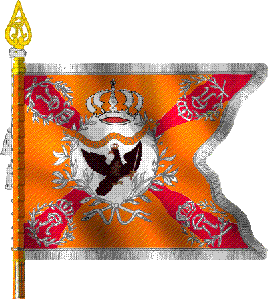
10th Dragoon Regiment 'von Finckenstein'
As with the standards and guidons of the French Army, Prussian standards were made from a material called 'gros de Tours'. In the case of the 9th and 10th Dragoons, most standards bore the cipher of Frederick William. Each received a Leibstandarte with Frederick's cipher towards the end of the war [this must be the War of Austrian Succession].
DR Nr.10: raised 1743, garrisoned in Sagan
Commanders: Jung-Möllendorf, 1754; Finck von Finckenstein, 1785; Rosenbruch (until 1790)
[The rest of the description is the same as above, except for the colours. The sheet is orange with scarlet wavy flames and a white centre on the regimental guidons, and white with red flames and an orange centre for the Leibstandarte. The scroll was orange/gold or white/gold. The crown was apparently silver instead of gold, although the laurels remained gold.]
Ian Sumner, 27 October 2000
[Editor's Note: The regiments did not have nicknames as such, but were frequently known by their colonel's name, rather than their number, so we have included those names for Frederick's reign where we have them. Naturally, this nickname would change with the changing of commanders. For our purposes we usually used the best known commander's name. Our thanks to Ian Sumner for providing the information.]
Prussian 2nd Cuirassiers Regiment 'Prinz Heinrich'
Preußische Nr.2 Kürassiere Regiment
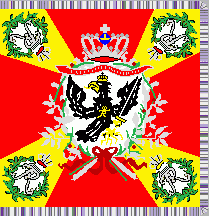 Image by Klaus-Michael Schneider
Image by Klaus-Michael Schneider
Ratio: 1:1
Colour of sheet and scroll: red
Colour of ornaments: silvery and green
Pattern of eagle: 1740
Colour of fringes: silvery
Additional elements: yellow wedges, golden cypher upon eagle’s breast, cyphers upon white discs
Source: Sources: [d2e92a]; p.21
Klaus-Michael Schneider, 31 January 2011
CR Nr.2: raised 1666, garrisoned in Wusterhausen & Pritzwalk
Commanders: Prinz von Preußen, 1758; Prinz Heinrich, 1767; Wirsbitzki, 1778; Weyher, 1782;
Saher, 1783; Backhoff (until 1789)
Prussian 4th Cuirassiers Regiment 'von Arneburg'
Preußische Nr.4 Kürassiere-Regiment
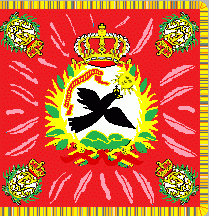 Image by Klaus-Michael Schneider
Ratio: 1:1 colour of sheet and scroll: red
Image by Klaus-Michael Schneider
Ratio: 1:1 colour of sheet and scroll: red
Colour of sheet and scroll: golden and green
Colour of ornaments: golden
Pattern of eagle: 1713
Colour of fringes: golden
Additional elements: cyphers upon white discs
Source: [d2e92a]; p.29
Klaus-Michael Schneider, 5 February 2011
CR Nr.4: raised 1672, garrisoned in Zulz, Ober-Glogau & Krappitz
Commanders:
Geßler, 1758; Schmettau, 1764; Woldeck von Arneburg, 1769; Arnim, 1785;
Mengden (until 1796)
Prussian 6th Cuirassiers Regiment 'Prinz Eugen'
Preußische Nr.6 Kürassiere-Regiment
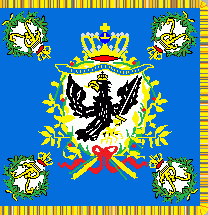 Image by Klaus-Michael Schneider
Image by Klaus-Michael Schneider
Ratio: 1:1
Colour of sheet and scroll: green
Colour of ornaments: golden and green
Pattern of eagle: 1740
Colour of fringes: golden
Additional elements: none
Sources: [d2e92a]; p.49
Klaus-Michael Schneider, 2 February 2011
CR Nr.6: raised 1688, garrisoned in Aschersleben & Croppenstadt
Commanders: Prinz Eugen, 1744; Stille, 1753; Baron von Schönaich, 1759; Vasold, 1769; Seelhorst, 1779; Hoverbeck, 1781; Rohr (until 1787)
Prussian 9th Cuirassiers Regiment 'Prinz von Schönaich'
Preußische Nr.9 Kürassiere-Regiment
 Image by Klaus-Michael Schneider
Image by Klaus-Michael Schneider
Ratio: 1:1
Colour of sheet and scroll: green
Colour of ornaments: golden and green
Pattern of eagle: 1740
Colour of fringes: golden
Additional elements: none
Sources: [d2e92a]; p.49
Klaus-Michael Schneider, 2 February 2011
CR Nr.9: raised 1691, garrisoned in Oppeln and Lowen
Commanders: Katte, 1741; Wartensleben, 1741; Möllendorf, 1743; Bornstedt, 1751; Prinz von Schönaich, 1758; Bredow, 1769; Podewils, 1784; Braunschweig (until 1787)
Prussian 11th Cuirassiers Regiment
Preußische Nr.11 Kürassiere-Regiment
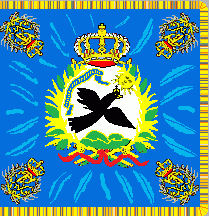 Image by Klaus-Michael Schneider
Image by Klaus-Michael Schneider
Ratio: 1:1
Colour of sheet and scroll: green
Colour of ornaments: golden and green
Pattern of eagle: 1740
Colour of fringes: golden
Additional elements: none
Sources: [d2e92a]; p.49
Klaus-Michael Schneider, 2 February 2011
CR Nr.11: Leib-Karabiniers: raised 1692, garrisoned in Rathenow and Burg
Prussian 2nd Dragoons Regiment 'von Württemberg'
Preußische Nr.2 Dragoner-Regiment
 Image by Klaus-Michael Schneider
Ratio: approximately 5:7 including tails
Image by Klaus-Michael Schneider
Ratio: approximately 5:7 including tails
Colour of sheet and scroll: golden yellow
Colour of ornaments: golden
Pattern of eagle: 1713
Colour of fringes: golden
Additional elements: dark orange wedges
Source: [d2e92a]; p.73
Klaus-Michael Schneider, 5 February 2011
DR Nr.2: raised 1725, garrisoned in Lüben and Bunzlau
Commanders: Sonsfeld, 1742; Württemberg, 1749; Schwerin, 1754; Blanckensee, 1757; Krockow, 1778; Württemberg, 1781; Mahlen (until 1790)
Prussian 3rd Dragoons Regiment 'von Schönaich'
Preußische Nr.3 Dragoner-Regiment
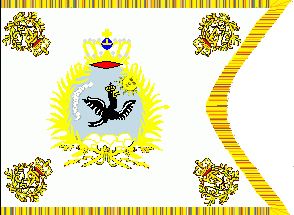 Image by Klaus-Michael Schneider
Ratio: approximately 5:7 including tails
Image by Klaus-Michael Schneider
Ratio: approximately 5:7 including tails
Colour of sheet and scroll: white
Colour of ornaments: golden
Pattern of eagle: 1713
Colour of fringes: golden
Additional elements: none, but note that according to source the 3rd and 4th Dragoons Regiment had standards without any recognizable difference
Source: [d2e92a]; p.77/81
Klaus-Michael Schneider, 3 February 2011
DR Nr.3: raised 1704, garrisoned in Küstrin
Commanders: Schulenburg, 1741;
Rothenburg, 1752; Baron von Schönaich, 1753; Truchseß, 1757; Meinicke,
1761; Flanss, 1763; Alvensleben, 1777; Thun (until 1788)
Prussian 8th Dragoons Regiment 'von Platen'
Preußische Nr.8 Dragoner-Regiment
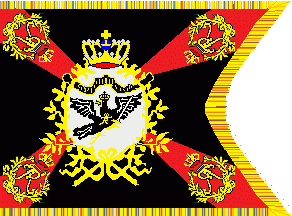 Image by Klaus-Michael Schneider
Ratio: approximately 5:7 including tails
Image by Klaus-Michael Schneider
Ratio: approximately 5:7 including tails
Colour of sheet and scroll: black
Colour of ornaments: golden
Pattern of eagle: 1740
Colour of fringes: golden
Additional elements: red wedges
Source: [d2e92a]; p.97
Klaus-Michael Schneider, 3 February 2011
DR Nr.8: raised 1744, garrisoned in Insterburg
Commanders: Stosch, 1751
Langermann, 1757 Platen, 1758 Alt-Platen, 1770 Platen (until 1787)
Prussian 12th Dragoons Regiment 'von Reitzenstein'
Preußische Nr.12 Dragoner-Regiment
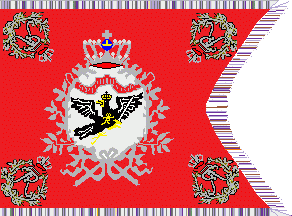 Image by Klaus-Michael Schneider
Ratio: approximately 5:7 including tails
Image by Klaus-Michael Schneider
Ratio: approximately 5:7 including tails
Colour of sheet and scroll: red
Colour of ornaments: silvery
Pattern of eagle: 1740
Colour of fringes: silvery
Additional elements: none
Sources: [d2e92a]; p.113
Klaus-Michael Schneider, 3 February 2011
DR Nr.12: transferred from Württemberg service in 1742, garrisoned in
Treptow and Wollin
Commanders: Alt-Württemberg; 1749 Prinz Eugen von Württemberg,
1769 Reitzenstein, 1780 Kalckreuth (until 1793)
Prussian 2nd Hussars Regiment 'Leibkorps Husaren von Zieten'
Preußische Nr.2 Leib-Husaren-Regiment
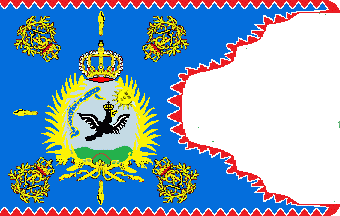 Image by Klaus-Michael Schneider
Ratio: approximately 11:18 including tails
Image by Klaus-Michael Schneider
Ratio: approximately 11:18 including tails
Colour of sheet and scroll: blue
Colour of ornaments: golden
Pattern of eagle: 1713
Colour of fringes: bordure of red triangles fimbriated white instead
Additional elements: none, but note that according to source the 3rd and 4th Dragoons Regiment had standards without any recognizable difference
Source: [d2e92a]; p.77/81
Klaus-Michael Schneider, 4 February 2011
HR Nr.2 Leib-Husaren-Regiment: raised 1730, garrisoned in Berlin.
Also known as Leibkorps Husaren von Zieten, after its first commander, Colonel Hans Joachim von Zieten. In 1743, the Zieten Hussars adopted their use of distinctive tiger-skin pelisse for their parade uniforms, with company officers wearing fur caps with heron feathers and field officers using an eagles's wing.
Please note, that NEUBECKER reports this standard, dated 1735 as that one of the 1st Hussars, but he probably is mistaken. According to the pictures of uniforms and saddle-cloths given in [d2e92a] the 2nd Hussars would be the only possible match. According to [d2e92a] the standards of hussars had been abolished in 1743 and are therefore not mentioned within source.
Klaus-Michael Schneider, 4 February 2011
[fie36] states each hussar regiment had one Leibstandarte and eight Regimentsstandarten. These were of the same pattern as previous reigns, but the motto and eagle were altered to Frederick II's standard pattern (so what Klaus-Michael depicts is the older style). Blue with a red border is not that of HR Nr.1 1735-41, but that of HR Nr.2, 1741-1743, so I wonder if in fact, this isn't actually a standard of HR Nr.1 after all, since it depicts a 1713-style eagle.
Ian Sumner, 21 April 2011
 Images by Klaus-Michael Schneider, 4 June 2011
Images by Klaus-Michael Schneider, 4 June 2011


 Image by Klaus-Michael Schneider
Image by Klaus-Michael Schneider Image by Klaus-Michael Schneider
Image by Klaus-Michael Schneider
 Image by Klaus-Michael Schneider
Image by Klaus-Michael Schneider Image by Klaus-Michael Schneider
Image by Klaus-Michael Schneider Image by Klaus-Michael Schneider
Image by Klaus-Michael Schneider Image by Klaus-Michael Schneider
Image by Klaus-Michael Schneider
 Image by Klaus-Michael Schneider
Image by Klaus-Michael Schneider
 Image by Klaus-Michael Schneider
Image by Klaus-Michael Schneider
 Image by Klaus-Michael Schneider
Image by Klaus-Michael Schneider
 Image by Klaus-Michael Schneider
Image by Klaus-Michael Schneider